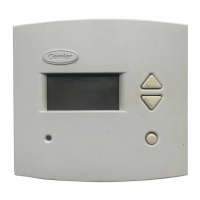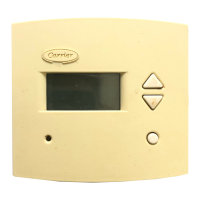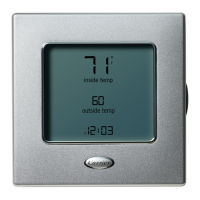4
NOTE: If single set point operation is used, the deadband will
be above and below the single set point.
SET POINT MINIMUM DIFFERENCE (Step 9) — The min-
imum difference between heating and cooling set points can be
user-configured. The range is from 0 to 6 degrees. The default
is 2 degrees. The minimum difference is enforced during
Autochangeover and Program On operation.
BACKLIGHT DISPLAY (Step 10) — The display backlight
can be set to ON (always on) or OFF (turn off 8 seconds after
usage). The default is OFF.
FAHRENHEIT/CELSIUS OPERATION (Step 11) — The
thermostat can be set to operate in Fahrenheit or Celsius
degrees. Set the variable to “F” for Fahrenheit operation. Set
the variable to “C” for Celsius operation. The default is “F.”
REMOTE SENSOR (Step 12) — The Remote Sensor con-
figuration is used to configure the operation of a remote sensor
(if used). If the configuration is set to YES, then the remote
sensor will function as an outdoor air temperature sensor (read
only). The thermostat will not control to the temperature. If the
configuration is set to NO, then the remote sensor will function
as a remote temperature sensor. The thermostat will control to
the temperature reading from the sensor. The default is YES.
OVERRIDE TIME DURATION (Step 13) — Step 13 is used
to adjust the amount of time that the override will activate
Occupied 1 set points during a programmed Unoccupied time
period. The range is 0 to 6 hours. The default is 2 hours.
DRY CONTACT SWITCH (Step 14) — Step 14 is used to
configure the dry contact switch as normally open (NO) or
normallyclosed(NC).ThedefaultisNO.
DRY CONTACT SWITCH OPERATION (Step 15) —
Step 15 is used to configure the operation of the dry contact
switch. When the dry contact switch is active, the thermostat
can enter Occupied or Unoccupied mode. If the configuration
is set to Occupied, then the thermostat will enter Occupied
mode when the dry contact switch is active. If the configuration
is set to Unoccupied, then the thermostat will enter Unoccupied
mode when the dry contact switch is active. The default is
Occupied.
NOTE: Step 16 will only be displayed if Step 15 is set to
Unoccupied.
DRY CONTACT SWITCH UNOCCUPIED OPERATION
(Step 16) — If the Step 15 configuration is set to Unoccupied,
then the thermostat will enter Unoccupied mode when the dry
contact switch is energized. Step 16 determines what the
thermostat will do when it enters Unoccupied mode. If the con-
figuration is set to Unoccupied Set Points, then the thermostat
will control to the unoccupied set points. If the configuration is
set to Off, the thermostat will turn off the fan coil during
Unoccupied mode. The default is to control to the unoccupied
set points.
The dry contact switch configuration allows for the dry con-
tact switch input to be used for a condensate overflow switch
when correctly configured. For example, when the drain pan is
full, a condensate switch would trip the dry contact, causing the
fan coil unit to shut off.
COM
G3/(Y)
G2/(W)
G
LO
MED
HI
(HEAT)
(COOL)
(VALVE)
FAN
COM
G3/(Y)
G2/(W)
G
LO
MED
HI
(HEAT)
(COOL)
(VALVE)
FAN
24vac
R
C
COM
COM
G
G
G3(Y)
G3(Y)
G2(W)
G2(W)
VA LVE
FAN
R
C
G2
W1
G3
Y1
G
33ZCRLYBRD
THERMOSTAT
Fig. 3 — Typical Wiring Diagram — 4-Pipe, 2-Relay Boards, Line Voltage Water Valves

